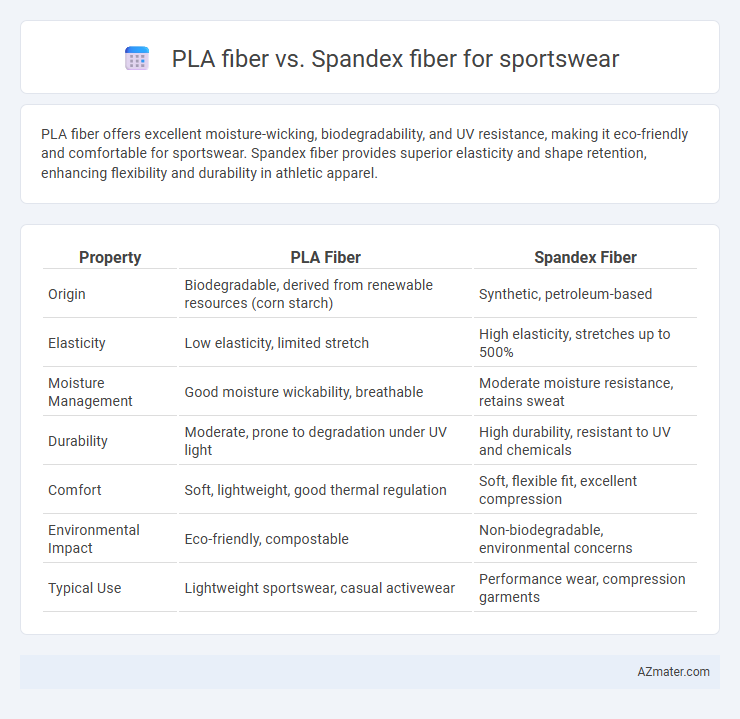PLA fiber offers excellent moisture-wicking, biodegradability, and UV resistance, making it eco-friendly and comfortable for sportswear. Spandex fiber provides superior elasticity and shape retention, enhancing flexibility and durability in athletic apparel.
Table of Comparison
| Property | PLA Fiber | Spandex Fiber |
|---|---|---|
| Origin | Biodegradable, derived from renewable resources (corn starch) | Synthetic, petroleum-based |
| Elasticity | Low elasticity, limited stretch | High elasticity, stretches up to 500% |
| Moisture Management | Good moisture wickability, breathable | Moderate moisture resistance, retains sweat |
| Durability | Moderate, prone to degradation under UV light | High durability, resistant to UV and chemicals |
| Comfort | Soft, lightweight, good thermal regulation | Soft, flexible fit, excellent compression |
| Environmental Impact | Eco-friendly, compostable | Non-biodegradable, environmental concerns |
| Typical Use | Lightweight sportswear, casual activewear | Performance wear, compression garments |
Introduction to PLA and Spandex Fibers
PLA fiber, derived from renewable resources like corn starch, offers biodegradable and moisture-wicking properties ideal for eco-friendly sportswear. Spandex fiber provides exceptional elasticity, enhancing stretch and recovery in performance garments for maximum comfort and flexibility. Combining PLA's sustainability with Spandex's durability results in innovative sportswear fabrics optimizing breathability, shape retention, and environmental impact.
Overview of PLA Fiber Properties
PLA fiber, derived from renewable resources like corn starch, exhibits high moisture-wicking capabilities and excellent breathability, making it suitable for sportswear that requires comfort during physical activities. Its biodegradability and low carbon footprint contribute to sustainable textile production, appealing to eco-conscious consumers in the athletic apparel market. PLA fiber also offers good thermal regulation and odor resistance, enhancing performance wear durability and user experience compared to synthetic fibers like spandex.
Overview of Spandex Fiber Properties
Spandex fiber exhibits exceptional elasticity, stretching up to 500% of its original length while maintaining durability, making it ideal for sportswear requiring flexibility and movement. It boasts excellent recovery properties, ensuring garments retain shape through intense physical activity and repeated washing. Moisture-wicking capabilities and resistance to body oils and lotions enhance comfort during workouts, distinguishing spandex from PLA fiber in performance applications.
Biodegradability and Environmental Impact
PLA fiber, derived from renewable resources like corn starch, offers excellent biodegradability, breaking down naturally within months under industrial composting conditions, making it an eco-friendly option for sportswear. In contrast, Spandex fiber, a synthetic polyurethane-based material, is non-biodegradable and contributes significantly to microplastic pollution during washing and disposal. The environmental impact of PLA fiber is substantially lower due to its renewable origins and compostability, whereas Spandex's production involves fossil fuels and chemical processes with higher carbon emissions and landfill persistence.
Moisture Wicking and Breathability Comparison
PLA fiber offers superior moisture-wicking properties due to its natural biodegradability and hydrophobic surface, effectively drawing sweat away from the skin to keep athletes dry. Spandex fiber excels in stretchability but has limited breathability and moisture management, often requiring blending with other fibers to enhance ventilation. Sportswear integrating PLA fiber promotes better airflow and quicker drying times, making it ideal for high-performance activewear focused on comfort and temperature regulation.
Stretchability and Comfort in Sportswear
PLA fiber offers excellent moisture-wicking properties and natural breathability, making it highly comfortable for sportswear, though its stretchability is moderate compared to spandex. Spandex fiber significantly outperforms PLA in stretchability, providing superior elasticity and shape retention critical for active movements in sports activities. Combining PLA with spandex blends can optimize sportswear by balancing comfort, moisture management, and dynamic stretch performance.
Durability and Longevity of PLA vs Spandex
PLA fiber exhibits moderate durability in sportswear, providing good resistance to UV rays and moisture but tends to degrade faster under prolonged mechanical stress compared to spandex. Spandex fiber offers superior elasticity and exceptional resistance to wear and tear, ensuring longer-lasting performance in high-stretch sportswear applications. While PLA is biodegradable, its lower tensile strength and abrasion resistance result in shorter longevity relative to the highly resilient and enduring spandex material.
Performance in Different Sporting Activities
PLA fiber offers excellent moisture-wicking and breathability, making it ideal for endurance sports like running and cycling, where temperature regulation is crucial. Spandex fiber excels in stretchability and recovery, providing superior flexibility and support needed for activities such as yoga, gymnastics, and high-intensity interval training. Combining PLA's natural odor resistance with Spandex's elasticity results in sportswear optimized for both comfort and performance across diverse athletic disciplines.
Cost-Effectiveness and Market Availability
PLA fiber offers a cost-effective, biodegradable alternative to traditional synthetic fibers with growing market availability driven by sustainability trends. Spandex fiber remains widely available and essential for sportswear due to its exceptional elasticity and durability, though it typically incurs higher manufacturing costs. Brands seeking affordable, eco-friendly options favor PLA blends, while performance-focused apparel continues to depend on spandex for superior stretch and comfort.
Conclusion: Which Fiber is Better for Sportswear?
PLA fiber offers excellent moisture-wicking capabilities, biodegradability, and breathability, making it ideal for eco-conscious sportswear brands targeting comfort and sustainability. Spandex fiber excels in elasticity, shape retention, and durability, providing superior stretch and support crucial for high-performance athletic activities. For sportswear prioritizing flexibility and long-lasting fit, spandex is better, while PLA fiber suits those emphasizing environmental impact and moisture management.

Infographic: PLA fiber vs Spandex fiber for Sportswear
 azmater.com
azmater.com